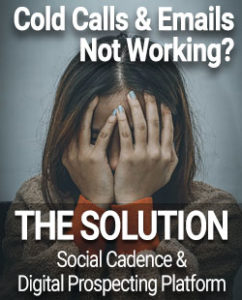Pipeline acceleration is always top of mind for a sophisticated Chief Revenue Officer (CRO.)
As a CRO, you must always close more deals faster. Pipeline velocity is the metric you live by. As the VP of Sales at FunnelAmplified, I can relate.
This year, I have a few million dollars to close by the end of Q4, and pipeline acceleration is all I can think of while my Marketing Director is busy thinking about generating leads.
Let’s be honest, the importance of building trust between buyers and sellers is not a breakthrough idea.
Any sales professional can intuitively understand why it’s vital to gain the confidence of prospective customers.
People buy from those sellers they know, like and trust.
But have you ever paused to consider what it truly means when buyers place trust in you?
What about when that trust isn’t just placed in you, but in every single person on your team?
The Impact Of Trust On Sales
Being trusted by prospects to provide insights on their challenges and help them as they progress through their Buyer’s Journey means that you and your sales team get to influence the purchasing decision early on.
Having your prospects’ trust means they’ll advocate for you and be the champion in the sales process, which leads to faster closings and better adoption rates.
In serving your prospects as a trusted advisor on their path from a problem to a good solution, you and your team gain not only the trust of your prospects, but also the trust of the referrals within that same account with different decision-making units, as well as within new accounts.
Earning your customers’ trust leads to cross-sell and up-sell opportunities, as well as higher annual recurring revenue (ARR) with lower churn.
The first step to trust in today’s fast-paced, all-digital B2B sales environment is thought leadership.
Five Types of Thought Leadership
- Industry expertise
- Vertical expertise
- Topical expertise
- Product expertise
- Industry Forecasting
Industry Expertise
An industry thought leader is an expert who understands his industry, how it works, what language it speaks and what unspoken rules it follows. This person stays on top the history of the industry, as well as what’s happening today and why. This type of thought leader has a solid perspective and offers insights on the trends and forces shaping the industry, as well as the impact of such forces on the industry players.
Vertical Expertise
A vertical thought leader is an expert who understands his specific industry vertical, how it works, what language it speaks and what unspoken rules it follows. This person stays on top the history of his chosen industry vertical, politics, evolving trends and competition. This type of thought leader has a solid perspective and offers insights on the trends and forces shaping this one industry vertical, as well as the impact of such forces on the stakeholders.
Topical Expertise
A topical thought leader is an expert who knows everything there’s to know about a specific topic. This person has answers to all questions potentially anticipated as it relates to the topic at hand. This type of thought leader reads books, attends webinars, speaks at conferences and writes blogs on this one topic. They have a solid perspective and offer insights on any and all aspects of the specific matter.
Product Expertise
A product thought leader is an expert who has hands-on experience with a specific product, its applications, limitations, integrations and transformation over time. This person stays on top the product evolution as its early adopter and super-user. This type of thought leader develops a solid how-to perspective and offers insights on the best use cases of the product.
Industry Expertise
Industry Forecaster is a unique kind of thought leader who doesn’t focus much on what was or what is. Rather, this person is an expert on what’s coming.
Your prospects need all five types of thought leadership described above as they progress through their Buyer’s Journey. Your pipeline depends on it!
Why?
The Reason Why Pipeline Acceleration Depends On Thought Leadership
When your prospects have faith in you to help them make their way through the stressful and overwhelming process of figuring out the right solution to their problem, you get their vote, and customers vote with dollars.
The State of Sales 2017 report found that buyers ranked trust as the single most influential factor in the buyer/seller relationship.
When you align your prospects’ pain points with your sales communications through quality content, your pipeline will grow faster and easier. You and your team members will be the solutionists in the eyes of your buyers.
How do you build trust?
Three Ways To Build Trust With Your B2B Sales Prospects
1. Establish your salespeople’s reputation as subject matter experts
Prospects want to make wise purchasing decisions. They typically feel guarded with sales reps who try to sell them. However, the sales reps who help prospects buy win their trust by being there for them.
The Edelman/LinkedIn survey found that the majority of decision makers find thought leadership important and spend hours engaging with it each week. They increasingly tend to value informed and respected individuals as credible sources of information on their Buyer’s Journey.
You can build personally branded mini-websites for your sales reps where each salesperson has thought leadership content available for prospects to view.
This is a place for prospects to use as a one-stop shop for all the content they need throughout their decision making journey.
Additionally it’s a hub from which salespeople draw brand-approved content, all personalized for each individual sales leader. The content uploaded by marketing and is high-quality and value-adding.
In response to the Edelman/LinkedIn survey, 64 percent of executives agreed that reading thought leadership content is among the best ways to get a sense for the type and caliber of thinking an organization is likely to deliver.
Of these executives, 49 percent agreed that thought leadership is also an important way to vet organizations.
2. Tell your story with content through your people
Buyers are trying to solve a puzzle as they gather information and review content. Often, they don’t yet understand the exact name of the problem they have, they don’t know the entire portfolio of solutions available to them and they are probably overwhelmed.
Your goal is to anticipate their questions and provide the answers in such a way that leads to a convincing conclusion, aka to buy from you.
Sharing relevant thought leadership content is a good first step toward positioning yourself as a valuable resource for your prospects.
CEB’s research found that managing all the information at their fingertips is one of the biggest B2B buyer challenges during the early stages of the purchase process.
A Raconteur survey found that one in five executives think content produced by brands offers little or no professional insight or value.
Today, 70 percent more people trust their peers more than they trust brands.
By enabling your sales team members to share brand-approved content with their peers, you are converting prospects into customers faster. This is because people like to buy from people in today’s human-to-human business environment. This enables you to build trust with your market.
To make it easy for the prospects to consume content from your team members, you can arm your sales leaders with personally branded mini-websites called Brand-Hubs. It’s easy for your sales team to use them because marketing fuels Brand-Hubs with value-added thought leadership content.
Brand-Hubs are the best way to help your prospects with “managing all the information at their fingertips.”
3. Address the emotional aspect of the Buyer’s Journey through storytelling
A majority of respondents to the Edelman/LinkedIn survey said they value facts and data in thought leadership content.
It makes sense that buyers look for objective information to justify their purchase choices.
However, stories sell. Peer-to-peer storytelling is incredibly powerful. Let your sales reps share storytelling content with your prospects who, after all, place their dollars where their emotions lead them.
The heart beats out the head, always!
The CEB research shows that second guessing (i.e., buyer’s remorse) occurs in more than 40 percent of completed B2B purchases. It’s understandable that other research found considerations about whether a purchase can enhance the buyer’s reputation or reduce anxiety play a large role in the B2B buying decision.
So, stories can help your sales team build trust with their B2B prospects.
Conclusion
Positioning your salespeople as thought leaders helps your pipeline acceleration because personalization and humanization of relationships leads to faster and easier purchasing decisions, in your favor, generating more revenue opportunities.
Would you like to see Brand-Hubs in action?

Thanks for reading. I typically write about modern selling, virtual selling, prospecting, sales reps reputation and how content helps all of these with modern buyers. My primary audience includes CEOs, CROs, CMOs, and other executives responsible for increasing bottom line. Post your questions in the comments section below and let’s discuss this!








